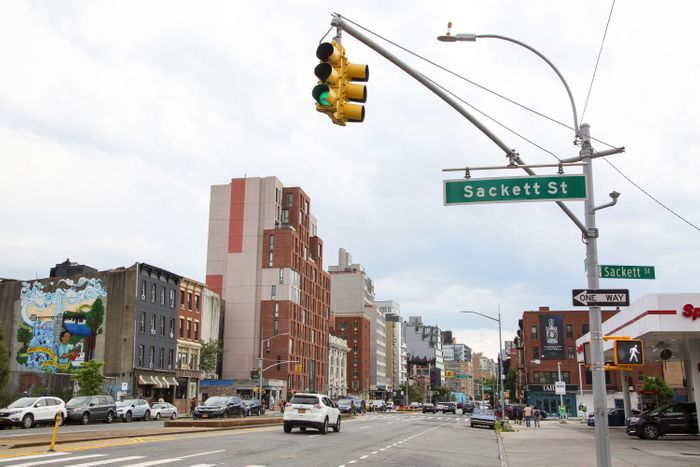
Shlomi Avdoo is standing on the second floor of the 12-story condo he’s building on the corner of Fourth Avenue and St. Marks Place in Brooklyn, gesturing out the window at where the living canopy will go. The canopy, a lushly planted decorative terrace that will wrap around this entire floor, is one of many thoughtful details incorporated into the building, called Saint Marks Place: the terra-cotta façade, the individual loggias (80 percent of the units here have private outdoor space), the illuminated marble alcoves in the master bathrooms. Upstairs, a penthouse recently sold for $5 million, which is serious brownstone money. Yet the scene outside the window — busy, unlovely Fourth Avenue, where a steady stream of box trucks and cars oozes down the traffic-laden thoroughfare — is decidedly not a brownstone view.
Fourth Avenue is useful but not pretty. It was memorably called a “canyon of mediocrity” after a Bloomberg-era rezoning transformed it from a charmless strip of automotive shops and bodegas into a charmless strip of automotive shops and bodegas interspersed with bland new residential developments. It’s become known as a street of nice-enough efficiency rentals and starter condos, forbidding to pedestrians but convenient if you need to rent a U-Haul or get to the BQE in a hurry. But recently, developers like Avdoo have been putting up buildings that are undeniably luxe, with spas and sunken gardens and other such amenities. They’re very different from the buildings dating to Fourth’s earlier waves of development, where the imperative was to maximize the zoning and residents’ convenience, not improve the local ambience. (The rezoning didn’t require ground-floor commercial space, so early developments put garages with curb cuts there.) Brendan Aguayo, a senior vice-president and managing director at Brown Harris Stevens Development Marketing who worked on some of those first condos, now admits that they were “uninspired, kind of sad-looking buildings.” But, he said, things are different now. “I can see the vision of the neighborhood. The new crop of projects are a significant improvement.”
Certainly, the new buildings’ prices are different. Parlour, another new condo nine blocks south of Avdoo’s project, sold out earlier this fall, its apartments ranging from $1.8 to $4.75 million. At Saint Marks Place, prices range from $1,300 to $2,000 per square foot. “We are to an extent pushing the market on the upper levels,” said Krystyn Gatto, a director at Avdoo & Partners. And 137 Fourth Avenue has sprawling (for New York, at least) 1,764-square-foot full-floor three-bedroom apartments in the mid-to-high $2 millions. Bill Caleo, co-founder of the Brooklyn Home Company, took it over from another developer who’d started out with plans to build two-bedroom apartments, two per floor. This struck Caleo as wrong-footed, something that might have been appropriate a decade ago but didn’t cater to the current crop of buyers.
When the rezoning passed in 2003, “developers didn’t know if anyone would want to live here. So they created entry-level housing,” Caleo said. “Base apartments, base finishes. I think Fourth Avenue got a bad rap because the quality really wasn’t there.” Now it is. To him, at least, the appeal of Fourth Avenue seems obvious, too — the ability to live in a new space in Park Slope, with better light than a brownstone and open views, close to the subway, the Barclays Center, Gowanus, and Boerum Hill. “Why can’t we make this really special?” Caleo said. “Create an elevated living experience on Fourth Avenue?”
Well, maybe because it’s Fourth Avenue: a highway feeding the Verrazzano-Narrows Bridge. Jamie Fedorko, an agent at Compass, is pragmatic about Fourth’s transformation: “Clearly, it’s improved. There’s more restaurants and shopping and high-end developments. But the vibe of the avenue hasn’t changed much and won’t change as long as it’s six lanes of traffic to and from the Verrazzano Bridge.” But even that may be changing, at least a little bit. The road now has protected bike lanes in both directions, and there are plans for a raised, landscaped median. Zoning changes also mean that new residential buildings are required to put commercial or retail space on the ground floor. Hypothetically, at least, all these things should make Fourth more welcoming to pedestrians and less of a traffic sewer. “Aesthetically, I think it will get better and better. I’m waiting for the day when it looks like Park Avenue,” said Tonya Benham, a Corcoran agent who has lived near Fourth Avenue for the past 11 years. (Long ago, it was in fact considered the Park Avenue of Brooklyn. By curious coincidence, Park Avenue in Manhattan was once known as Fourth Avenue, and it was an undesirable address until the rail tracks were moved underground.) Besides, busy streets don’t necessarily dissuade wealthy buyers, Benham pointed out, citing the West Side Highway.
Developers do seem wary of leaning into their avenue location, playing up instead the nearby brownstone lifestyle. The builders of Saint Marks, for example, very consciously chose to orient the building around its namesake side street, and Avdoo says a lot of buyers approvingly noted it. Parlour is likewise marketed as “a building that reinterprets the romance of life in a classic brownstone.” And Arbor Eighteen, a now-sold-out condo project, bills itself as a “home that grows with you on the greener side of Brooklyn.” Brooklyn Home Company, meanwhile, is building an adjoining condo around the corner from its Fourth Avenue project, on Butler Street; the two will share amenities and a sales launch and, Caleo hopes, will capture buyers who like the project but may be lukewarm on the location. Not that he thinks they should be. “What is truly the difference between being on Fourth Avenue and having extra light and being on Union between Fourth and Fifth?” he said. “Right now, there is a consumer difference between those things, but there shouldn’t be.”
The thing is, wealthier buyers don’t really need to be convinced — they’re already buying on Fourth, Aguayo pointed out. “Arbor Eighteen, we’re sold out, 251 First Street sold out, Parlour sold out with a penthouse that went for $4.75 million, Saint Marks is 65 percent sold, 6 Garfield is over 50 percent sold,” he said. “The earliest projects, it was mostly Brooklynites, first-time home buyers, young couples. I don’t think the demographic has changed too much, but the price is significantly different and the quality is too. There’s also more demand.” And more Manhattanites and people from the West Coast — about 50 percent of buyers are now from outside Brooklyn, according to Aguayo, up from 25 percent before the pandemic.
“I’ve worked with some buyers, maybe they’re leaving Manhattan for the first time, they’re used to living in a big amenitized condo building on a busy avenue,” said Fedorko, the Compass agent. “Yeah, it’s not pretty, but people want a product you otherwise can’t get in brownstone Brooklyn. They’re more focused on that than the street.”
It helps that the new apartments tend to be large, as large as brownstones in some cases, and don’t need renovation or involve any of the hassles of living in a smaller co-op, where everyone becomes a de facto board member. “At Parlour, they decided to do 2,000-square-foot two-beds and 4,000-square-foot four-beds. They really are competing with brownstones,” said Adam Rolston of INC, the architecture firm that designed Parlour and Saint Marks Place. At the latter, INC used layers of greenery to insulate apartments from noise and less-than-picturesque views and recessed bedrooms away from the avenue. And, brokers pointed out, Fourth Avenue is really a very convenient location, at the nexus of Boerum Hill, Gowanus, and Park Slope, with a subway line on it.
“It’s a really easy neighborhood for a lot of people,” said Deborah Rieders, a broker at Corcoran. “Not everyone will live there, for sure, but if the building is thoughtfully designed and the prices are commensurate with what people expect, they will. There are always apartments not facing Fourth Avenue.”
And, she added, “the simple truth is that there aren’t a lot of places left to build in prime, prime locations anymore.” Zoning and historic districts mean that most charming brownstone blocks are off-limits to new construction, which tends to get corralled into busy, unsightly locations on the outskirts of quaint neighborhoods: Atlantic, Flatbush, Ashland Place, or Fourth in Downtown Brooklyn, or the cluster of condos around the BQE in Carroll Gardens. Kent Avenue in Williamsburg is on the water, but it’s far from the subway and for years had little in the way of retail. Dumbo is charming, but it’s crisscrossed by highways and trafficky bridge approaches. “What you hear from buyers is almost resignation,” said Fedorko. “‘I understand in my heart this is not where I want to be. But if I want amenities, a door person, I’m probably going to Fourth.’”
But Brooklyn and the reasons people choose to live in the borough have also changed. “The Brooklyn lifestyle, you’re not going to find it on Fourth Avenue, but the new Brooklyn — what is the new Brooklyn? A lot of dense neighborhoods with towering skyscrapers,” Fedorko said. “This low-rise green neighborhood is just not the vision anymore.”
There are also people who’ve lived the brownstone Brooklyn fantasy and realized it wasn’t for them, like John Chan. Chan and his wife bought a gut-renovated townhouse on the border of Prospect and Crown Heights ten years ago. It seemed like an idyllic place to raise a family, but after having two children, they felt like too much of their time was spent dealing with the problems that inevitably cropped up in a 100-plus-year-old house. “As a homeowner, when the roof was leaking, I felt trapped,” Chan said. “We wanted to spend as much time as possible with our kids.” He and his wife decided to buy a three-bedroom condo at 6 Garfield, on the corner of Fourth. Chan said he wasn’t bothered at all by Fourth’s lack of charm — there are plenty of pretty streets nearby if he wants to go for a stroll. “I don’t have to live on a block to enjoy the block,” he said. As for living above a steady stream of traffic, he was just glad that he wouldn’t be stuck in it anymore. The location is so convenient — close to his kids’ schools, the arts scene in Gowanus, and restaurants in Park Slope and a half-block from the subway — that he plans to sell their car as soon as they’re able to move in this spring.








